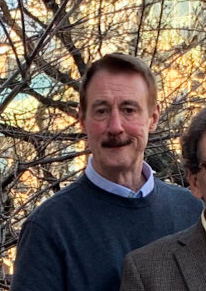They had all been students at Columbia University’s historic preservation program. And, today Jay Shockley, Ken Lustbader, Andrew Dolkart, and Amanda Davis are all notables in the field of historic preservation scholarship. As founders in 2015 of the NYC LGBT Historic Sites Project, they have identified hundreds of sites around NYC’s five boroughs that have LGBT relevance.
The founders all participate in decisions about which sites are included, they divvy up who writes about which site, and then the group reviews each piece. Each one may choose to write about a building they know well or one that represents a challenge to delve into the depth of New York history as the project includes sites from the 17th Century to the year 2000. The group has written the stories of 439 of these places, which are posted online. In their database, there are several hundred more to go.
Shockley worked as a staff member of the New York City Landmarks Preservation Commission for 35 years. His richly detailed reports on buildings under consideration by Landmarks for landmark status are extraordinarily evocative. For example, reading Shockley’s 2007 report on the 104th Street Automat, you can almost imagine walking into the Automat at 104thStreet and Broadway, taking in the customers from varied walks of life and enjoying all the ingenious design elements of the Automat and its Art Deco style from the dolphin coffee spouts to the glorious terra cotta ornamentation on the building’s facade.
Minus wait staff and supervisory managers, the Automat was known to appeal to people of all ages, lifestyles, and ethnicities. It was popular for mink coat-wearing matrons, high school students and the homeless, or those with nowhere to go apart from single rooms with no kitchen. The Automat, like other cafeterias of the time, was also a meeting place for Gays who could feel comfortable and mostly free of harassment. While no specific photos or memorabilia tie the 104th Street Automat to Gay customers, substantial information about Automats in Philadelphia and New York City strongly suggests that here too, it was a venue that was attractive to blue-collar and low-paid workers who were gay, according to Shockley.
Shockley first spoke with Lisa Hurwitz, filmmaker of the acclaimed documentary “The Automat,” when she was still a student and then again some years later in 2022, for a showing of the film at the Church of St. Paul the Apostle and St. Andrew. He was pleased that she had integrated all the most important points from his report into her film. In relation to the NYC LGBT Historic Sites Project, the founders are always on a quest for more information about specific places. Regarding the 104th Street Automat, the group anticipates the possibility of evidence in old police files for any indication of problematic activity. Also, more generally, Shockley said that anyone with information about a NYC site that has a connection to gay life is encouraged to send a draft for the group to review. “They should know they will have four editors,” he said.
Shockley, originally from Baltimore, came to the city to go to Columbia in 1978. The 104th Street Automat, built in 1930, had already been closed for nearly 20 years. He had been to Automats as a child on family visits to relatives that included taking in a movie and show at Radio City Music Hall, followed by dinner at a nearby Automat. “I loved it for all the reasons people say they loved Automats,” he said, noting that it was the nickels to be placed into slots to magically unlock little doors that opened on pies and sandwiches that drew his attention rather than the food itself.
Later, as a scholar writing a report on the Automat, he came to admire its outstanding terracotta ornamentation that is very similar to the work of the famous architectural terracotta master Rene Paul Chambellan.
Today, Shockley marvels that the Upper West Side still has two Automats whose basic exterior fabric has remained intact: The former 104th Street Automat and the one-time Automat on West 72nd Street are among very few vestiges of a marvelously inventive creation.

 By
By